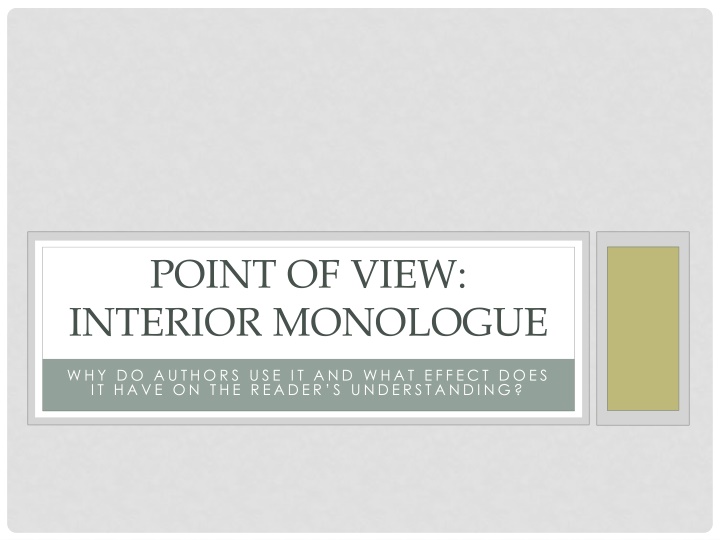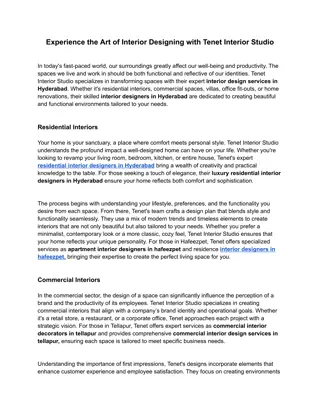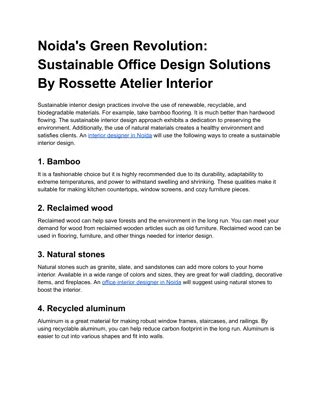Use of Interior Monologue in Literature
Authors utilize internal monologues to provide insights into characters' thoughts, emotions, and reactions. By exploring examples from works like "The Shining" and "Discovery," readers can grasp how interior monologues enhance storytelling by revealing inner conflicts and character development.
Download Presentation

Please find below an Image/Link to download the presentation.
The content on the website is provided AS IS for your information and personal use only. It may not be sold, licensed, or shared on other websites without obtaining consent from the author.If you encounter any issues during the download, it is possible that the publisher has removed the file from their server.
You are allowed to download the files provided on this website for personal or commercial use, subject to the condition that they are used lawfully. All files are the property of their respective owners.
The content on the website is provided AS IS for your information and personal use only. It may not be sold, licensed, or shared on other websites without obtaining consent from the author.
E N D
Presentation Transcript
POINT OF VIEW: INTERIOR MONOLOGUE W HY D O A U THO R S U SE I T A ND W HA T E F F E C T D O E S I T HA VE O N THE R EA DER S U NDER STA NDI NG?
WHY WOULD AN AUTHOR USE AN INTERNAL MONOLOGUE? To show how the narrator is reacting to his immediate surroundings the monologue tells the story of what is going on. To show how the narrator presents their thoughts as memories the monologue reviews past events and connects them with present ones. To show that the narrator s train of thoughts are neither a record of the present nor a recollection of the past the monologue is purely a reflection, and in itself, the story.
WHEN DO AUTHORS USE INTERNAL MONOLOGUE? While few short stories are compromised entirely of a monologue, many writers use this point of view in a limited capacity. Monologues also appear in the form of diary entries and letters, which perhaps are easier for a reader to understand The next few slides show examples of interior monologue and how it affects the reader s understanding
EXAMPLES OF INTERIOR MONOLOGUE FROM STEPHEN KING S THE SHINING He closed his eyes and all the old phrases began to parade through his mnd, it seemed there must be hundreds of them. (craking up not playing with a full deck lostya marbles guy just went looney tunes he went up and over the hig side went bananas lost his football went crackers nuts half a seabag) All meaning the same thing: losing your mind. No, he whimpered, hardly aware that he had been reduced to this, whimpering with his eyes shut like a child. Oh no, God. Please, God no. King uses interior monologue in a limited capacity. The interior monologue is shown by using parenthesis. The use of interior monologue here shows the reader what is going on in the character s mind and just how crazy the character is becoming.
EXAMPLES OF INTERIOR MONOLOGUE FROM PAUL SERVINI S DISCOVERY What now? The last ten years of my life have been spent trying to forge a career in business. Yet, it was more than a career at stake. I was looking for an identity after Robin. I found it. The cost was high but I paid it willingly because it made me into someone. I needed that. So I closed my eyes and went for it. Today, someone opened my eyes and I recoiled. Is this really what I ve become? And is there any way out? Servini uses interior monologue through the use of a diary entry. He uses diary entry to compare how the character is confident on the outside but insecure on the inside.
EXAMPLES OF INTERIOR MONOLOGUE FROM JASMINE GALLANT S NOT MY NAME I am so cold huddled at my little desk, pounding on this keyboard I feel the breath rush out of my lungs, freezing the air in front of me. A coffee sits beside me, its warmth leaks away. A cigarette smokes lazily in the ashtray. Rings drift to the ceiling like a young girl s hair. Stray books and clothes have a life of their own and come to rest wherever they find space in our small, cramped living room. Why do I write these things? These things of no importance? Gallant uses interior monologue through the use of a diary entry. Her narrator is becoming more and more confused. His memories are told in the present tense and his everyday observations are told in the past tense. The interior monologue allows the reader to understand his emotions and fears.
THE ADVANTAGES AND DISADVANTAGES OF USING INTERIOR MONOLOGUE Advantages to using Interior Monologue Disadvantages to using Interior Monologue internal monologues give readers an intimate view into a character s life, thoughts and feelings An interior monologue can be touching and make the reader understand the character better interior monologues are a fairly limited approach not to mention a biased one Interior monologues can also be tough to articulate authentically because thinking doesn t happen in grammatically correct sentences (we don t think in big words, our thoughts are broken)























